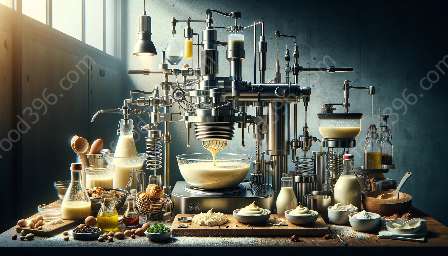Emulsifying is a fundamental process in food preparation that greatly influences the texture, appearance, and flavor of various dishes. It involves the mixing of two or more immiscible liquids, such as oil and water, to form a stable and uniform blend known as an emulsion. This topic cluster delves into the intriguing science behind emulsifying, explores different emulsification techniques, and highlights its crucial role in food preparation.
The Science of Emulsifying
Emulsifying is a complex but essential process that occurs on a molecular level. At its core, emulsions are mixtures of two immiscible liquids, typically a hydrophilic (water-loving) phase and a hydrophobic (water-repellent) phase. Common examples include oil and vinegar in salad dressing, or egg yolk and oil in mayonnaise.
When these liquids are combined, emulsifiers such as lecithin or proteins stabilize the mixture, preventing the individual components from separating. This stabilization occurs due to the amphiphilic nature of emulsifiers, which means they have both hydrophilic and hydrophobic properties. The hydrophilic portion of the emulsifier interacts with the water phase, while the hydrophobic portion interacts with the oil phase, bridging the gap between the two.
Emulsification Techniques
Emulsification can be achieved through various techniques, each of which has its own set of advantages and considerations. Some of the most commonly used techniques include:
- Mechanical Emulsification: This technique involves using mechanical energy to disperse one liquid phase into another. This is often accomplished through vigorous stirring, blending, or the use of specialized equipment such as homogenizers, which break down fat globules into smaller, more uniform particles.
- Temperature Control: Controlling the temperature of the emulsion components can also affect the stability and consistency of the final product. For instance, cooling an emulsion can thicken it, while heating can enhance fluidity and aid in the mixing process.
- Emulsifying Agents: Emulsifiers, including natural substances such as egg yolk and mustard, or artificial ones like mono- and diglycerides, can be added to facilitate emulsification and maintain the stability of the mixture.
- High-Pressure Homogenization: In this advanced technique, the emulsion is forced through a narrow gap at high pressure, resulting in the formation of smaller droplets and a more stable product.
Relevance to Food Preparation
Emulsifying plays a vital role in food preparation across a wide range of culinary applications. It is responsible for creating creamy dressings, smooth sauces, rich mayonnaise, and even airy foams in modern gastronomy. Without the process of emulsification, many beloved dishes and culinary innovations would not exist.
Moreover, emulsifying affects not only the texture of foods, but also their appearance and palatability. Emulsions can contribute to a luscious mouthfeel, enhance flavor release, and provide a visually appealing sheen to the finished product.
Conclusion
Emulsifying is a fascinating and essential aspect of food preparation. Understanding its underlying science and mastering the various emulsification techniques can greatly enhance a chef's ability to create exceptional dishes. The art and science of emulsifying continue to inspire culinary innovation and elevate the sensory experience of food for consumers worldwide.

